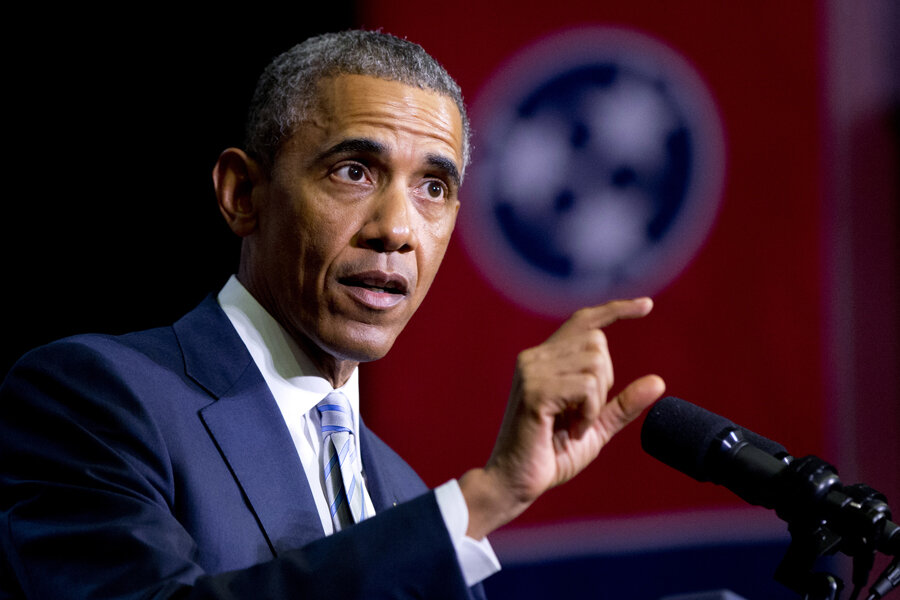Obama's misfire on 529 college savings plan: Who is middle class?
Loading...
| Washington
The Obama administration’s decision to backtrack on a tax proposal that would have gutted a popular college savings plan is a telling moment for this White House. At its heart lie perceptions of who is “middle class.”
The episode also raises questions about Obama White House coordination with Democratic leaders on Capitol Hill, who came out against the plan (as did Republican leaders and families saving for college).
As part of proposed changes to the tax code, Mr. Obama wanted to end some of the tax advantage of so-called 529 college savings accounts. Millions of Americans have such accounts, though ownership skews toward better-off families. White House economists had concluded that other education tax breaks would do more for the middle class than 529s.
But the outcry against the 529 switch was swift – and not just from families and Republican leaders. Top Democrats, including House minority leader Nancy Pelosi and House Budget chairman Chris Van Hollen, advised the White House to drop the proposal. Leader Pelosi reportedly pressed senior administration officials on the matter Tuesday while flying on Air Force One with the president between India and Saudi Arabia. Tuesday afternoon, the administration relented, calling the pushback a “distraction.”
Obama had only unveiled the plan the weekend before his State of the Union address on Jan. 20. In relenting so quickly, the administration was cutting its losses. But the episode has also given the Republican Party a lifeline as it seeks to portray itself as a friend of the middle class.
“Democrats are in real trouble heading into 2016 if they think raising taxes on middle class families counts as ‘middle class economics,’ ” Republican National Committee Chairman Reince Priebus said in a statement.
Obama focused heavily on “middle class economics” in his latest State of the Union address. But that emphasis – and now the 529 kerfuffle – only begs the question: What is the middle class?
The short answer is that there’s no universally agreed upon definition. So that leaves those making the arguments to set their own. And in politics, that’s a gift: The middle class can be whatever you say it is.
The vast majority of Americans consider themselves middle class, including most of those whose income puts them in the top fifth of American earners. So even if the 529 plans disproportionately benefit those with higher incomes, calling those people “wealthy” and not in need of some kind of incentive to save for the children’s college education felt like a slap in the face.
The second reality for the Obama 529 switch was that opponents were able to quickly attack one aspect of the plan, and the administration never recovered.
Currently, owners of 529 accounts – typically a parent or another family member – put money aside for qualified educational expenses, and it grows tax-free. It will also not be taxed when it is withdrawn.
Under Obama’s proposal, new 529 accounts would still have grown tax-free, but money withdrawn would have been taxed. Conservatives latched onto the “tax hike” element of Obama’s proposal and ran with it.
“People don’t care that a wealthy person might also own a 529 plan,” wrote Ryan Ellis, tax policy director at Americans for Tax Reform, in Forbes last week. “People care that they own a 529 plan, and that Obama is seeking to tax it out of practical existence.”
On Monday, Rep. Lynn Jenkins (R) of Kansas introduced a bill that would expand college savings plans and keep them tax-free.
The Obama administration had argued that its approach would simplify the current maze of plans and provisions for college savings that confuse some taxpayers. It would also help pay for Obama’s plan for free community college, costing $60 billion over 10 years.
But that opened another line of argument against Obama’s plan – that it would tilt families more toward sending their children to community college and away from four-year colleges and universities.
The tax increase from the new rules for 529s would have raised $1 billion between fiscal years 2016 and 2025. In announcing Tuesday that it would not ask Congress pass that piece of its tax plan, the Obama administration said it would still call for an expanded tuition tax credit. Obama releases his fiscal year 2016 budget on Monday.
Though White House economists maintained that 529s are tilted toward the upper end of the income spectrum, data on the plans show that many other Americans benefit from the plans as well. Currently, there are some 12 million 529 accounts, and the average balance is about $20,000.








